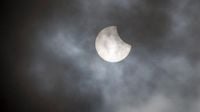On Saturday, March 29, 2025, a partial solar eclipse will captivate viewers across Saxony, Germany, provided the weather cooperates. This celestial event, where the moon partially obscures the sun, will create a stunning visual effect, making the sun appear as though a piece has been bitten off. The last time residents in Saxony were treated to such a sight was in October 2022, and the next opportunity will not come until August 12, 2026.
The phenomenon occurs during a new moon when the moon passes directly between Earth and the sun, aligning almost perfectly in the same plane. As a result, the sun's disk will be partially covered, allowing for approximately 1.5 hours of observation around midday on March 29. However, the extent of the coverage varies by location. In Dresden, for example, the maximum coverage will be about 12.2 percent at 12:18 PM. In Leipzig, it will happen about two minutes earlier, while in Görlitz, it will occur slightly later.
Frank Bok, an expert from the Dresden-Gönnsdorf Observatory, emphasized the importance of safety during such observations. “Never look directly at the sun without proper protection, especially not through binoculars or telescopes,” he cautioned. “An unprotected view of the sun can lead to severe eye damage.” To safely enjoy the eclipse, Bok recommends using eclipse glasses, which are available at optical shops for a minimal cost. He further warned that makeshift solutions like regular sunglasses, soot-covered glass, or other homemade filters do not provide adequate protection.
The weather forecast for Saxony on March 29 indicates a mix of cloudy and clear skies, which could affect visibility. According to the German Weather Service (DWD), many areas may experience overcast conditions, potentially hindering the chance to witness this rare astronomical event. However, there might be occasional breaks in the clouds, offering glimpses of the eclipse.
In conjunction with the partial solar eclipse, March 29 also marks a nationwide Astronomy Day in Germany, with several observatories hosting special events. The Sternwarte Radebeul will open its doors at 11 AM, featuring short lectures, guided tours, and planetarium shows. Adults will pay seven euros, while children can enter for four euros.
The Dresden-Gönnsdorf Observatory will also welcome visitors starting at 11 AM, allowing them to observe the partial solar eclipse through telescopes equipped with special filters and projection screens. Following the eclipse, attendees can participate in afternoon lectures covering a range of astronomical topics.
Meanwhile, the Schulsternwarte Bautzen will be open from 11 AM to 9 PM, offering free entry for families and children without requiring prior registration. The Sternwarte Nordsachsen, located in Schkeuditz and Eilenburg, has already booked all available spots for eclipse viewing in its planetarium. However, if the weather permits, telescopes will be accessible outside the Eilenburg location for public use.
Additionally, the Sternwarte in Sohland an der Spree will celebrate Astronomy Day starting at 11 AM, inviting the public to join in on the festivities. The Zwickau Planetarium and Observatory will also host events, contingent on favorable weather conditions for viewing the eclipse.
The partial solar eclipse on March 29 is not just a visual spectacle; it also serves as a reminder of the intricate dance between the Earth, moon, and sun. This event will begin in northwestern South America, where the moon's penumbra first touches the Earth, before moving north across the United States, Canada, and the North Pole, eventually reaching northern Russia. The eastern edge of the moon's shadow will glide over Europe, allowing many to experience this spectacular occurrence.
As the excitement builds for the partial solar eclipse, the public is encouraged to participate in the various events planned across Saxony. Whether through observatories or community gatherings, this is a unique opportunity to witness a celestial event that connects us to the rhythms of our universe.
In summary, the partial solar eclipse on March 29, 2025, promises to be a spectacular event for those in Saxony, Germany, with various observatories prepared to enhance the viewing experience. However, safety remains paramount, and viewers must take precautions to protect their eyes while enjoying this rare astronomical display.





